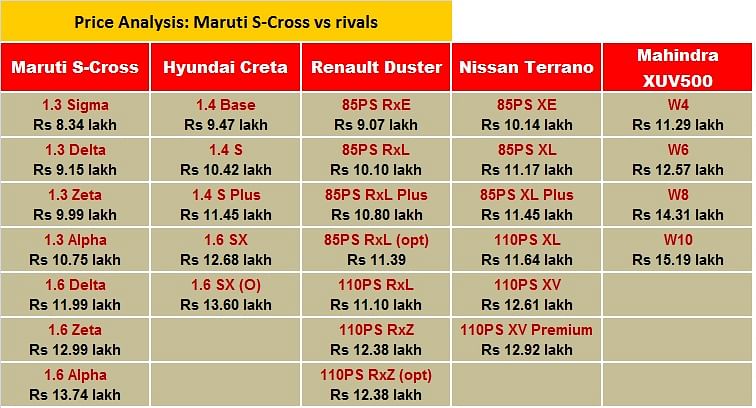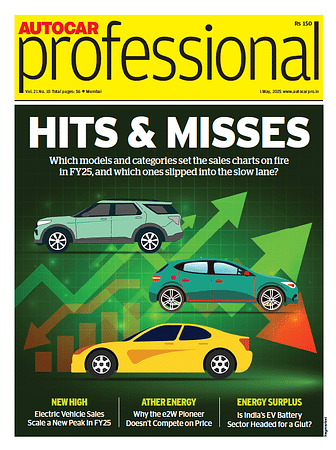Is the Maruti Suzuki S-Cross’s pricing too premium?
The sizeable price differential between the two diesel options is Rs 3.65 lakh for the base models and around Rs 2.84 lakh for the Delta variants.
Maruti Suzuki today launched its first premium crossover, the S-Cross, which is expected to open up a plethora of opportunities for the carmaker in this new segment. But has Maruti got its pricing right?
The crossover rolls out with twin diesel options – the DDiS 200 1.3L across four variants (Sigma/ Rs 8.34 lakh, Delta/Rs 9.15 lakh, Zeta/Rs 9.99 lakh and Alpha/Rs 10.75 lakh) as well as the DDiS 320 1.6L at Rs 11.99 lakh for Delta trim, Rs 12.99 lakh for Zeta, and Rs 13.74 lakh for the Alpha variant.
What’s surprising is the sizeable price differential between the two diesel options at Rs 3.65 lakh for the base models and if both the Delta variants are compared then roughly Rs 2.84 lakh. The difference between both the Alpha variants in DDiS200 and DDiS320 is again Rs 2.99 lakh. This could dent the sales of the DDiS 320 S-Cross when a customer has the option of purchasing a compact SUV at the same rate. Then why would he opt for a crossover?
Kenichi Ayukawa, managing director and CEO of Maruti Suzuki India, told Autocar Professional on the sidelines of the launch, “We will have to study the pricing whether the difference is too much between the two variants.”
However, RS Kalsi, executive director (sales and marketing), said the price difference is based on the engine quality and performance; the more powerful 1.6-litre diesel compared to the 1.3-litre motor. He is of the opinion that with the pricing the company has tried to be competitive and will attract more customers to the Nexa showrooms. Also while 1.6-litre DDiS 320 is an imported engine from Fiat, the DDiS 200 is an in-house motor.
“When one drives the car, then one will understand why this difference has been kept. I will say it is due to the extra power of the engines. The customer will finally decide but this was the lowest possible price we could have offered.”
Interestingly, in a first Maruti has also given the diesel variants premium names unlike the earlier VXi and LXi editions. This is to create the difference in the minds of customers about the new premium brand and hence a different nomenclature has been given to the S-Cross variants. This is expected to draw customers to the premium Nexa outlets where the S-Cross will be retailed. The premise is that the customer will definitely come and enquire what features are available on the new crossover that would create further awareness about the premium model.
Meanwhile, Maruti Suzuki has a full pipeline of models for both its distribution networks – the regular one and the premium Nexa showrooms. Since the S-Cross is developed on a new platform, many new models can be further developed on this platform of a similar size. According to Ayukawa, around 2 or 3 vehicles of the overall same size but different types can be developed. A challenging exercise but the carmaker is carefully considering which product to develop on this platform next in terms of a sedan or an SUV.
Since the S-Cross will be retailed at only 35 Nexa outlets to start with and their number is to be ramped up to 100 only by March 2016, sales of the crossover are expected to be limited initially but once the network is expanded sales of 4,000 units per month are the target.
But the question that begs an answer is how will Maruti Suzuki decide the brand positioning of its upcoming models at the Nexa outlets and those at the regular dealerships?
“We will decide based on customer clinics as to which customer profile fits which model and accordingly we will distribute the models. For the S-Cross, the target customer is young and tech-savvy, likes to have a digital experience and takes decisions on the smartphone. That category of customers is headed for the premium Nexa outlet where a digital experience is assured by the carmaker,” said Kalsi, hastening to add that the company is undertaking research on it and is analysing profiles.
Another aspect of the new crossover launch is that while the signage in the Nexa showrooms will sport the Maruti Suzuki name, the company’s name has been removed from the rear of the vehicle in line with international trends. Most premium vehicles sold globally do not have the manufacturer’s name. Instead the technology and the manufactuer logo are embedded. The S-Cross, in addition to the S (for Suzuki) logo in the front, will sport the Nexa logo and technology at the rear to guide customers to Nexa outlets.
Maruti says about 35,000 enquiries have been received for the S-Cross which is available at Nexa outlets for test drives and bookings. The S-Cross is being produced at the carmaker’s Gurgaon plant where the production line can be flexed as per demand.

RELATED ARTICLES
Bajaj Auto launches new Chetak 3503 at Rs 110,000
The Chetak 3503, with a claimed range of 155km, 63kph top speed and a slower charging time than its 35 Series siblings, ...
Hyundai walks the eco talk with biogas plant, material recovery plant in Gurugram
Operational since October 2022, the facility targets sustainable waste management in Gurugram by undertaking scientific ...
Rajiv Bajaj reappointed MD and CEO of Bajaj Auto for five-year term
Bajaj Auto’s Board of Directors has approved the re-appointment of Rajiv Bajaj as the company’s MD and CEO for another f...






 By Shobha Mathur
By Shobha Mathur
 05 Aug 2015
05 Aug 2015
 12688 Views
12688 Views









